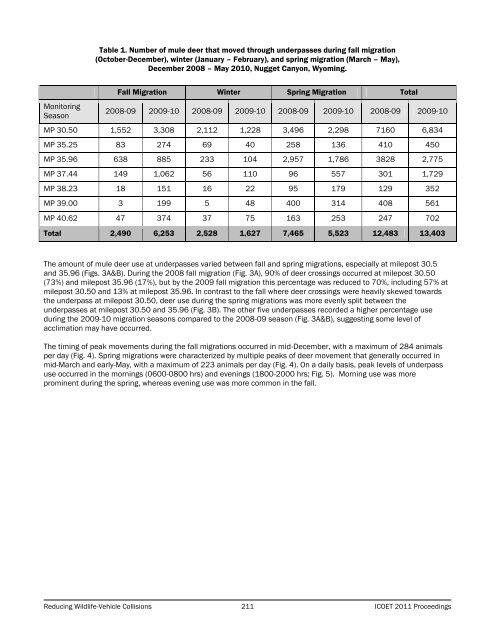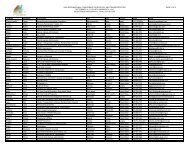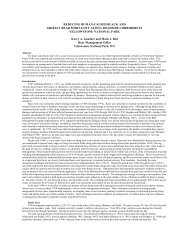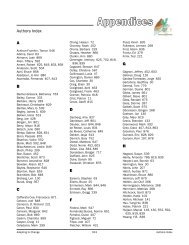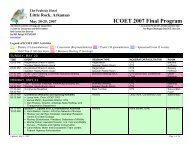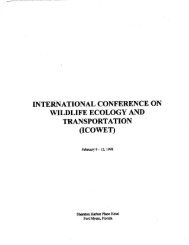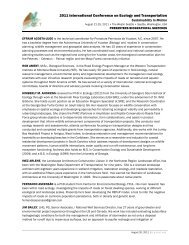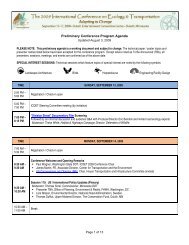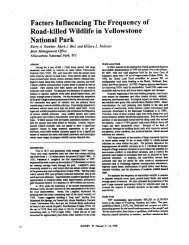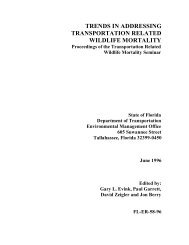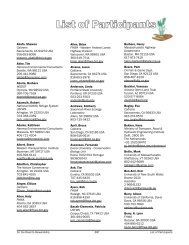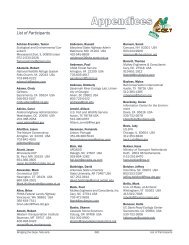COM-1, pages 179-226 - ICOET
COM-1, pages 179-226 - ICOET
COM-1, pages 179-226 - ICOET
You also want an ePaper? Increase the reach of your titles
YUMPU automatically turns print PDFs into web optimized ePapers that Google loves.
Table 1. Number of mule deer that moved through underpasses during fall migration(October-December), winter (January – February), and spring migration (March – May),December 2008 – May 2010, Nugget Canyon, Wyoming.Fall Migration Winter Spring Migration TotalMonitoringSeason2008-09 2009-10 2008-09 2009-10 2008-09 2009-10 2008-09 2009-10MP 30.50 1,552 3,308 2,112 1,228 3,496 2,298 7160 6,834MP 35.25 83 274 69 40 258 136 410 450MP 35.96 638 885 233 104 2,957 1,786 3828 2,775MP 37.44 149 1,062 56 110 96 557 301 1,729MP 38.23 18 151 16 22 95 <strong>179</strong> 129 352MP 39.00 3 199 5 48 400 314 408 561MP 40.62 47 374 37 75 163 253 247 702Total 2,490 6,253 2,528 1,627 7,465 5,523 12,483 13,403The amount of mule deer use at underpasses varied between fall and spring migrations, especially at milepost 30.5and 35.96 (Figs. 3A&B). During the 2008 fall migration (Fig. 3A), 90% of deer crossings occurred at milepost 30.50(73%) and milepost 35.96 (17%), but by the 2009 fall migration this percentage was reduced to 70%, including 57% atmilepost 30.50 and 13% at milepost 35.96. In contrast to the fall where deer crossings were heavily skewed towardsthe underpass at milepost 30.50, deer use during the spring migrations was more evenly split between theunderpasses at milepost 30.50 and 35.96 (Fig. 3B). The other five underpasses recorded a higher percentage useduring the 2009-10 migration seasons compared to the 2008-09 season (Fig. 3A&B), suggesting some level ofacclimation may have occurred.The timing of peak movements during the fall migrations occurred in mid-December, with a maximum of 284 animalsper day (Fig. 4). Spring migrations were characterized by multiple peaks of deer movement that generally occurred inmid-March and early-May, with a maximum of 223 animals per day (Fig. 4). On a daily basis, peak levels of underpassuse occurred in the mornings (0600-0800 hrs) and evenings (1800-2000 hrs; Fig. 5). Morning use was moreprominent during the spring, whereas evening use was more common in the fall.Reducing Wildlife-Vehicle Collisions 211 <strong>ICOET</strong> 2011 Proceedings


